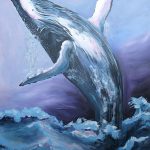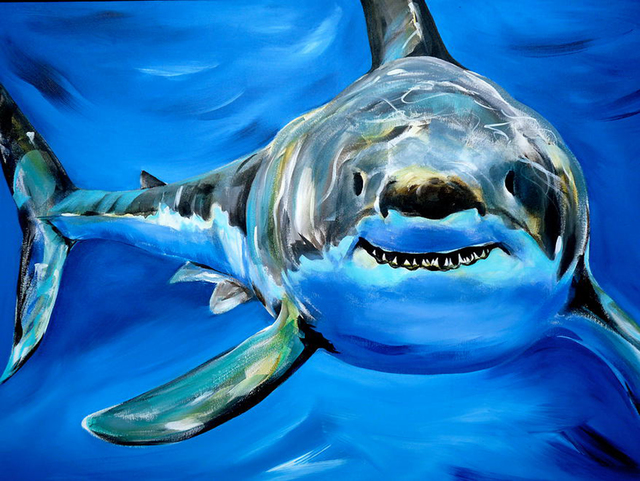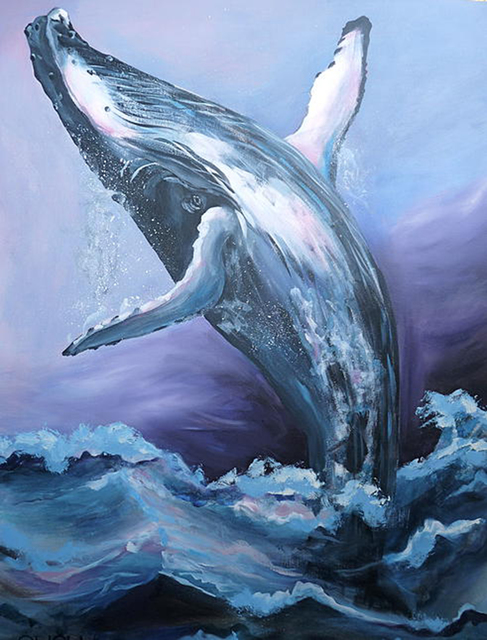Artist Susun Gallery may be having a ‘Blue-Purple-Playful Period’


As a working artist for the past 28 years, Susun Gallery knows the color wheel like the back of her paint-smudged hand. While significant, that’s not the only color comprehension that Gallery brings to students’ lives. While teaching the foundational elements of art — line, shape, form, color and composition — she also guides students into the magical heart of painting: The emotional color that springs forth, for instance, as an effervescent Mona-Lisa-smile gracing an otherwise ordinary painting.
On a Saturday afternoon, three 9-year-old students from the Kahakai Elementary School, which is where Gallery teaches, are attending an extra art class at the artist’s private studio. The girls can’t seem to get enough of Auntie Susun and her colorful lessons.
Angel Afan arrives early. She has several paintings in process, including the bright red hibiscus she’s working on today. “It’s fun,” she says. “It makes me happy.”
“Angel and some of the kids are advancing really quickly,” said Gallery. “Others in the classroom have almost no drawing ability but they’re keeping up. I go really slowly so everyone is included.”
Gallery’s own art education began early in San Jose, Calif.
“The first thing I ever drew was the inside of my parents’ drawers – lipstick, makeup, socks. We had a grand piano and my sister and I decorated it from underneath with the lipstick and my sister’s autograph pencil,” said Gallery, said she always felt comfortable drawing and painting. “It’s a gene I think. It’s such a personal joy.”
The horizon line
Bubbly with excitement, two more students, Brook Lewandowski and Diana Shishikin, arrive at the studio for class. She gives the girls little canvases.
“What subject do you like?” asks Susun. “As long as you’re painting what you love, you’ll do well.”
Lewandowski and Shishikin finally decide to paint seascapes, which is one of Gallery’s favored subjects too: she can use some of her favorite blue colors. “I like using Cerulean blues,” she says. “They’re in every beautiful sky all around the world.”
Canvases are set up on easels. Disposable palettes, water, brushes and rags are handed out.
“Now imagine you’re looking out at the sea while looking at your canvas,” instructs Gallery. “Lay a piece of masking tape across the canvas where the horizon line will be.” That horizon line is 30 miles away, she says. “How will we bring it closer for the viewer to experience?”
Her students scratch their heads, thinking with both sides of their brains, wondering how they can perform this color magic.
Shape and color
“Paint above the masking tape, thinking only about sky. Which way does the wind blow? Wind goes side to side, right? So brushstrokes will go the same way, side to side,” Gallery says, demonstrating with a brush in the air.
She lays out dabs of acrylic paint on the palettes. “First, titanium white, it’s whiter than white. Next, ultramarine blue. It’s nice to have primary colors out there.” It might be easier to squeeze purple or green from a tube, but Gallery urges students to blend their own unique colors.
“You get the undertones,” she says. “You can use pre-mixed purple, but for some reason, the quinacridone magenta and blue make a much better purple.” She lays out French ultramarine blue, phthalo green, lemon yellow, raw sienna, and her beloved cerulean blue.
“Do we have everything for sky here?” she asks Lewandowski and Shishikin. They nod, eager to get their brushes in paint.
Gallery encourages big, bold strokes. “Ready? Pick up some white. Mix it with cerulean right on the canvas. Use your brain. Think: is this the color I want? Look at the height of the sky. Because of atmosphere and the clouds, it’s darker at the top and goes to lighter at the horizon line. So we put the darker at top, to create dimension.”
“Alright. No fear. Go for it. You can always change it if you don’t like it.”
Art on the beach
Children aren’t the only students who find their way into Gallery’s art classes. Despite her modesty, she teaches people from all over the world in her “Art on the Beach” classes held at some of Kona’s most spectacular seashores and fish ponds. The imagination plays a role in art, even when you’re painting from real life, she asserts.
She points to a seascape that vibrates with color: cobalt blue, ultramarine blue, violet and cadmium yellow. “You take away what you don’t want to be there. See? This is the Banyans, without the condos. You can do anything you want. I take a lot of artistic license. That’s what makes it exciting.”
You can, as Gallery does in her own paintings, add blue and white highlights to give bland compositions a new dimension. That’s how she gave a lovable shark its toothy Mona Lisa smile in her painting, “Karma.”
A celebration of the blues, both literally and symbolically, the painting blends cool turquoise, teal and sapphire blue to bring out the best in a manu, a tiger shark.
“This shark painting was inspired by a life crisis,” says Gallery of her 30-by-40-inch piece titled, “Karma 30×40.” “But everyone loves a happy face, so I gave it a happy grin. This painting says, ‘treat adversity with a smile.’”
Gallery’s use of blue and blue-purple, barely warmed by other colors, has troubled some of her critics who say she uses “too much color.”
With “Winter Whale Breach,” she tried to control her palette. “It did not work for me,” she says. Deciding finally to follow her muse, “The painting came alive again with several blues and purple. As long as the colors in your paintings are not competing with each other for attention, color gives the painting huge emotional value.”
Picasso had what was called a “Blue Period,” when monochromatic choices reflected his feelings about his war-torn homeland, Spain. Now they are some of his most popular works, but he had difficulty selling those blue paintings at the time.
Gallery may be having her “Blue-Purple Period,“ and if so, she’s in the perfect place for it. Azure ocean, cobalt blue skies, Egyptian blue evenings, ultramarine mornings — is there any blue that can’t be found in Kona?
Gallery believes art can teach anyone — novice, seasoned or master — to relieve stress by composing elements in a positive and meaningful way. Understanding choices and balancing goals are essential for everyone, youth and adults alike. Struggling or not, the need for art education, especially in schools, is critical. It’s been shown in countless studies: arts education leads to improved test scores and happier students.
As she dreams up her next painting or prepares to teach another class, the colors on Gallery’s palette spread out beyond the edges of her canvas, bringing more color to life. She shares the magical heart of painting, giving new hues and highlights to make magic in the endless blue skies.
For more information on Gallery, visit www.susungallery.com.
Contact writer marya.mann@gmail.com



